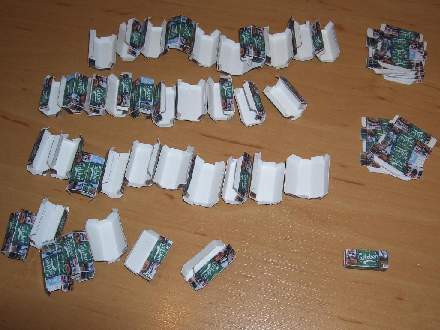Katzhagen - Archive - November 2009
Modelling mania...
was what I was suffering from three times during the past weeks. On the one hand because of a beer cans' overpack which I brought along from our last vacations in Denmark and on the other by a very accidental purchase of some used LGB vehicles.
Truckload: Beer cartons
Both of the Calanda sliding wall cars had more than plenty of space for import-beer..This led to the idea of putting the cardboard packaging of a 10-pack Carlsberg beer cans onto the scanner. The resulting electronic picture was scaled down and then copied to a new picture several times. Afterwards it was printed on a A4-size sheet of thick paper (approx 180g/m2). The following pictures show the further handling.
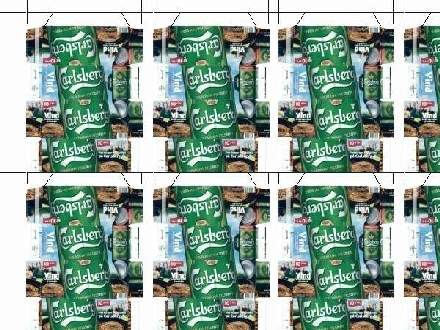
Based upon a scanned packaging
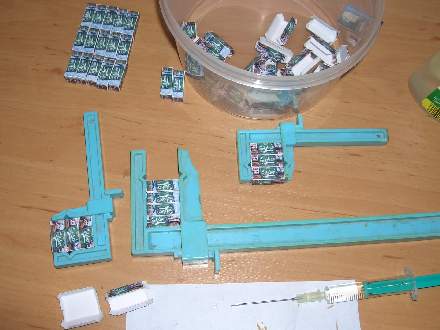
After prefolding the bracket joints, a bit of paper glue is applied
using a cannula equipped 2ml-syringe.
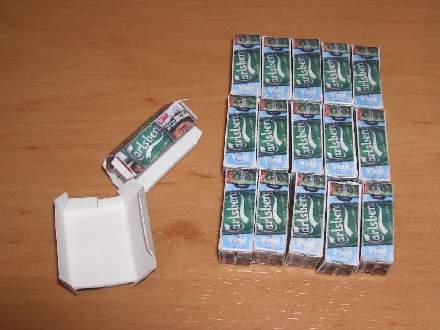
For a completely equipped pallet around 100 cartons are necessary.
This definitely is no game for impatient people - but for maniacs.
A tank car's metamorphosis
Getting hold of an item which was desired for a long time often happens suddenly by an unexpected coincidence. Lately, when a friend offered me an old "LGB" tank car, I remembered that I intended to complete my tank car train with an ESSO car. Since the modification of another tank car worked quite excellent, I decided to buy the "LGB" tank car and to torture the air brush gun once again: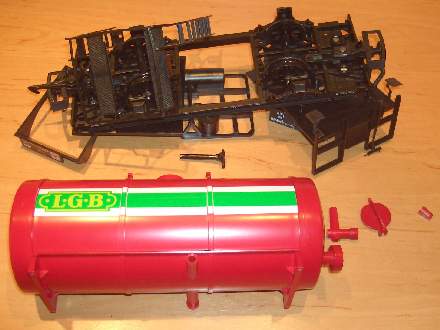
The tank was removed from the chassis to simplify revarnishing.
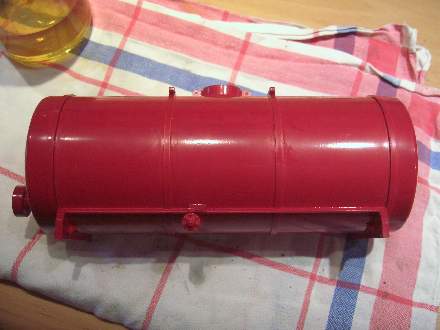
The lettering was removed from the tank
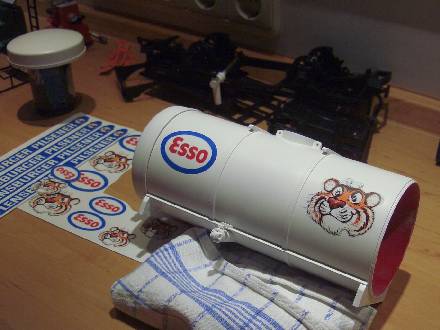
A new lettering was applied
In order to simplify the work, the tank was removed from the chassis. An easy exercise thanks to just four screws.
Next the tank's lid and locking mechanism as well as its drain valve were removed.
After removing the lettering with the help of a little brake fluid, the tank's surface was sanded wet with a grit size of 600.
Then it was varnished using satin white color and the new lettering, which meanwhile had been implemented on the computer, was applied. The finishing was done using a mix of satin and glossy clear varnish (1:2) which provides for both an additional protection and less visible edges of the labels.
A closer look also reveals that the old plastic axles were replaced with new metal axles.
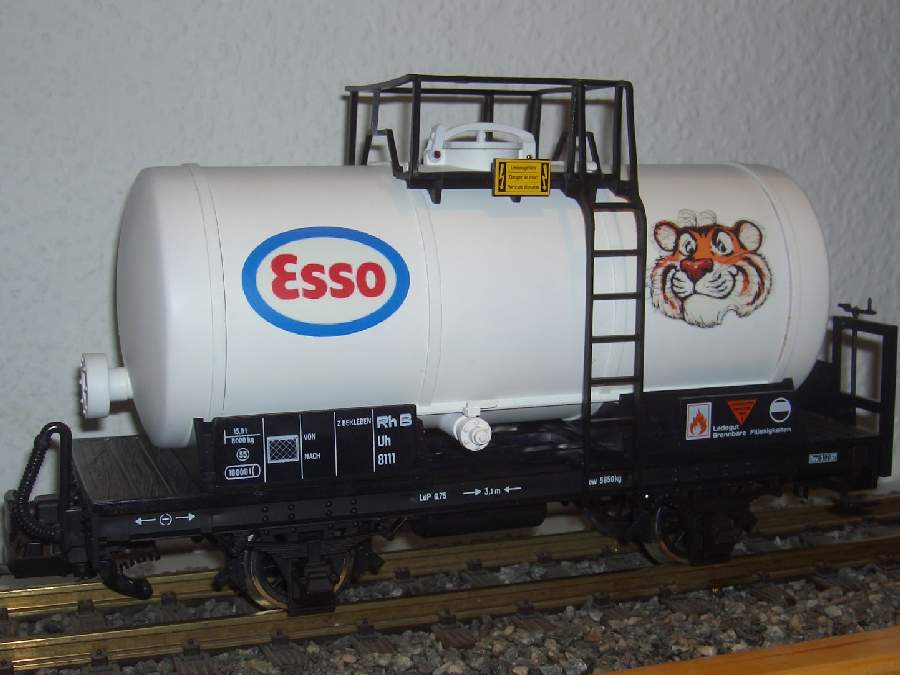
A new variation on the Esso theme.
An old Tram
always had been a sort of teaser for me but I never made up my mind to purchase such a vehicle since it doesn't match my layout's characteristics in my eyes. But life is full of surprises - I got an irresistible quote.Unfortunately, I had to recognize that this new possesion's technical equipment was a bit ancient: It featured a gearbox of the old kind and an illumination based upon 19V bulbs. The latter was not useable until the vehicle was running at a ridiculous fast speed. No doubt, a starting delay and a new illumination was necessary...
As in this assembly the motor is powered through two metal stampings made of
brass, this power supply had be cut in order to loop in a starting delay.
This was done by shortening a nose on each of both brass parts and leading two
cables into the housing (see picture on the right). Four pairs of antiparallel
diodes were inserted into these cables which were connected to the vehicles
internal power pick up from the gearbox. The cables were installed outside
the gearbox below the vehicle's ground plate.
The eight diodes result in a voltage reduction of approx. 4V which is a sort
of simple starting delay (in fact it's more a shift of voltage). This is
sufficient for the new illumination to light up while the vehicle is standing
still. Nevertheless the vehicle's final velocity with 24V on the tracks remains
too high. But one isn't obliged to use full throttle...
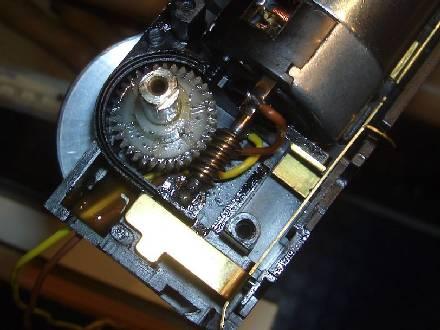
Modification of the motor's power feeding
A new illumination
working at just 5V while the vehicle is standing still was achieved quite simply by replacing the old bulbs with E5.5-socket-LEDs. Since these LEDs are specified for up to 19V DC or (!) AC, an additional 1k Ohm series resistor was used with each of the LEDs (see pictures below) for security reasons.
Red 5mm LEDs were used for the implementation of working tail lights. These were connected to a simple voltage stabilization which was placed behind the vehicle's front plate.
working at just 5V while the vehicle is standing still was achieved quite simply by replacing the old bulbs with E5.5-socket-LEDs. Since these LEDs are specified for up to 19V DC or (!) AC, an additional 1k Ohm series resistor was used with each of the LEDs (see pictures below) for security reasons.
Red 5mm LEDs were used for the implementation of working tail lights. These were connected to a simple voltage stabilization which was placed behind the vehicle's front plate.
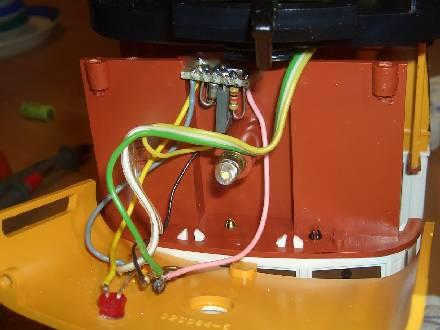
Extended and redesigned front illumination

Interior illumination based upon LEDs
Since I didn't enjoy the ex factory advertisement on the roof for a well-known liver-goo, I decided to create an ad-banner of my favourite amber liquid. A laser printer, clear self-adhesive film and a bit of satin clear varnish were used for this exercise.
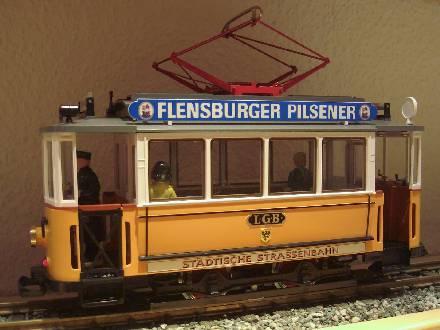
New ad...
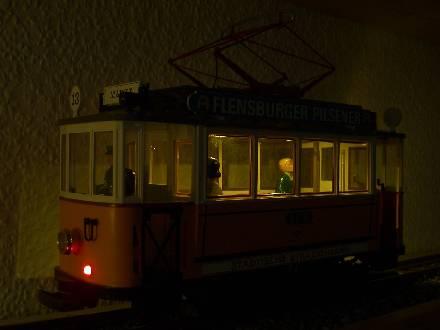
... and a new illumination - fancy.

